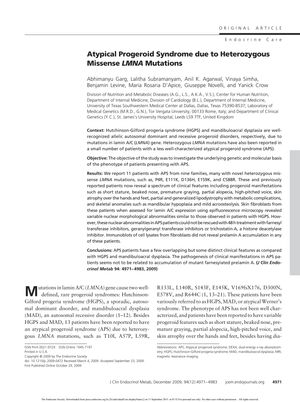Atypical Progeroid Syndrome Due to Heterozygous Missense LMNA Mutations

TLDR The research found that Atypical Progeroid Syndrome has unique symptoms and is not caused by the buildup of a certain mutant protein.
The study investigated the genetic and molecular basis of atypical progeroid syndrome (APS), a condition with clinical features similar to Hutchinson-Gilford progeria syndrome (HGPS) and mandibuloacral dysplasia, which are caused by mutations in the LMNA gene. The researchers reported on 11 patients from nine families with APS, identifying several novel heterozygous missense LMNA mutations. These patients exhibited a range of progeroid symptoms, including short stature, beaked nose, premature graying, partial alopecia, high-pitched voice, skin atrophy, lipodystrophy with metabolic complications, and skeletal anomalies. Skin fibroblast studies showed nuclear morphological abnormalities, but unlike HGPS, these abnormalities in APS patients could not be corrected with certain inhibitors, and there was no prelamin A accumulation observed. The study concluded that APS has some distinct clinical features from HGPS and mandibuloacral dysplasia, and the pathogenesis of APS does not appear to be related to the accumulation of mutant farnesylated prelamin A.
